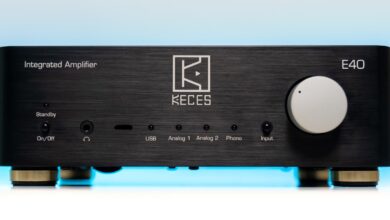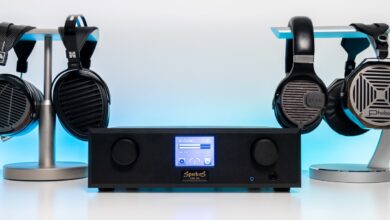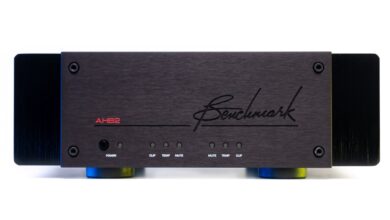Singxer SA-1 Class-A Headphone Amplifier Review

My Video Review:
Singxer Electronic Co Ltd. is a mysterious audio manufacturer for me, they have done ODM and OEM work for third party companies for more than a decade now. They started slow and small, but they learned fast, they did their homework so well, that in fact the second generation XMOS digital receivers were developed and optimized by the help of the Singxer team…I’m impressed already. Digital audio is already running deep through their veins, just look at their product portfolio. How many manufacturers do you know that have 3 digital interfaces under their belts? It is a clear sign that they know their stuff very well, they even released several D/A converters, with their latest SDA-6 PRO being quite interesting due to its Hybrid PLL, high current Class-A output stage and to a custom FPGA solution.
But there is something missing from their product portfolio though, not a single analog amplifier carries their name…up until recently when they announced their first Singxer Amplifier 1 or SA-1 for short, designed as a fully balanced and completely discrete (no op-amps in the signal path) Class-A amplifier for your headphones, that can also work as a line-stage for your power amplifier. As with all Class-A amplifiers, it offers a constant amplitude regardless of your volume position, so you can forget about external interference crawling inside. SA-1 incorporates a complete protection system against over-currents, overloads, short circuits as well as thermal protection, DC protection and switch-on delay so you can sleep tight while SA-1 is burning-in your freshly acquired headphones. Providing some ~6.5 Watts under 32Ω, Singxer SA-1 looks on paper like the last amp you’ll ever need, offering plenty of juice even for the most difficult loads. Could Singxer deliver the same performance and razor-sharp precision as their digital creatures are doing? Let’s find that out together!

Unboxing Experience
I am greeted with the same good old packaging, double boxed is the usual business, there is plenty of soft foam that completely surrounds the unit for a better protection during shipping. Besides the unit itself that seems quite heavy and well-built, you’ll find a power cable and a simple user-manual that will hint a little about the unit and its features. I wish they mentioned all its specs as there is none of that, I am particularly interested in its power drain, so I can calculate its working mode. SA-1 can also be used as a preamplifier as it has a pair of RCA and XLR outputs on its back, but you will need to manually adjust its volume as it doesn’t have a remote control.
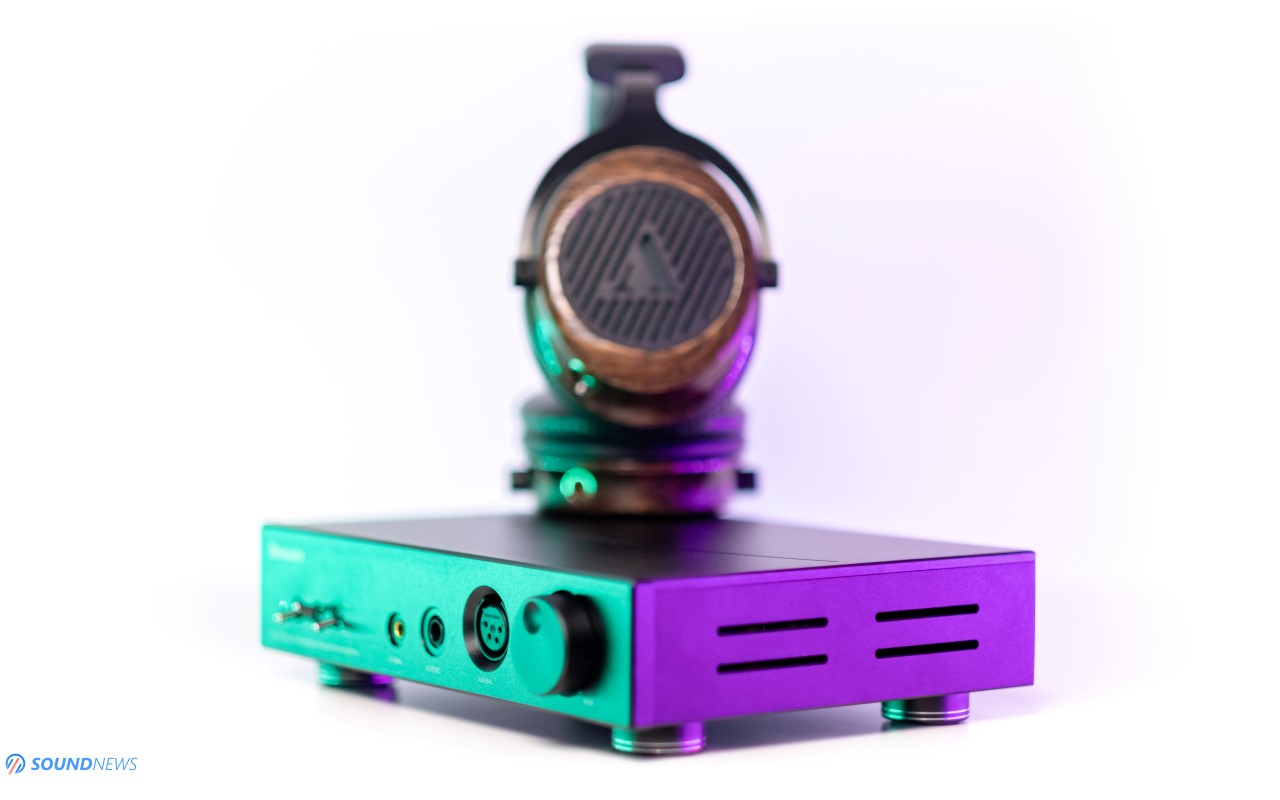
Design & Build Quality
This is my first experience with a Singxer product, but preliminary impressions are looking quite good. It seems to be well-built, it has a thicker aluminum enclosure, especially its front plate looks tank proof. There aren’t bells and whistles with this one, it looks like an old-school amplifier with just a handful of mechanical switches and with an analog volume pot to its right. You won’t see an LCD screen, some complicated menus or anything like that. It looks like a metal brick that is painted in matte black, it doesn’t attract a lot of eyes and maybe that’s what I like the most about it. There is only a minuscule LED on its front that shows its working status and that’s all the light pollution you’ll get from it. I particularly like its thick and oversized metal feet with rubberized rings that will absorb micro-vibrations. Since it is a Class-A amplifier, it should dissipate more heat to a traditional amplifier, so you can see four wider opening on its sides, there is another one on its back that will move hot air outside its case, prolonging the life of its electronics. All the screws were moved to its back and under the unit, for a clean minimalist look. At about 1.8 kilos (3.9 lbs) it is on the heavier side, especially considering its very small footprint, which adds some confidence that I’m dealing with a high-quality product. Size wise, it’s just a little bigger to a Topping A90 and it’s much smaller to all Class-A amplifiers I’ve tried to this point.
If you’re using sensitive and hard to drive headphones on a daily basis, there is one thing that will became annoying and quite fast, I am about its gain switches that you can spot on its belly. Yes, switches…four of them to be more precise and you need to turn them when it’s powered off, otherwise it can damage your precious headphones or IEMs. A single switch on its belly would look much nicer or better yet, a simple Low/High gain switch on its front plate would look fantastic! On the other hand, I understand that PCB re-design can take months of component relocation, polish, measurements and so on. If they left them right there for a better sound quality and for a shorter signal path, then I’m taking my words back and my hat off.

Controls & I/O
It has a super simple front panel with 3 switches located on its left, the first one lets you choose its working mode; it is either a preamp, a headphone amp or it goes to stand-by mode, the next one lets you choose its RCA or XLR input and the last one changes the output impedance for its headphone outputs. Low-Z (low-impedance) offers 1.4 Ω on balanced and 0.7 Ω on single ended and Hi-Z (high-impedance) adds 10 Ω to both outputs, resulting in a higher resistance of 11.4 Ω on balanced and 10.7 Ω on its 6.35 mm (1/4”) jack. SA-1 is quite impressive when it comes to headphone outputs, you are getting a regular headphone jack and two balanced outputs coming in 4-pin XLR and 4.4 mm Pentaconn flavors. Its volume wheel on the right seems to be using an analog ALPS Blue Velvet pot that is being used in a lot of amplifiers of today.
On its back you’ll find a universal AC inlet (100 V to 240V) with automatic voltage detection, so you can use it anywhere without flipping a switch. I’m glad seeing a mirror image as far as inputs and outputs go. Be them RCA or XLR, it got you fully covered.
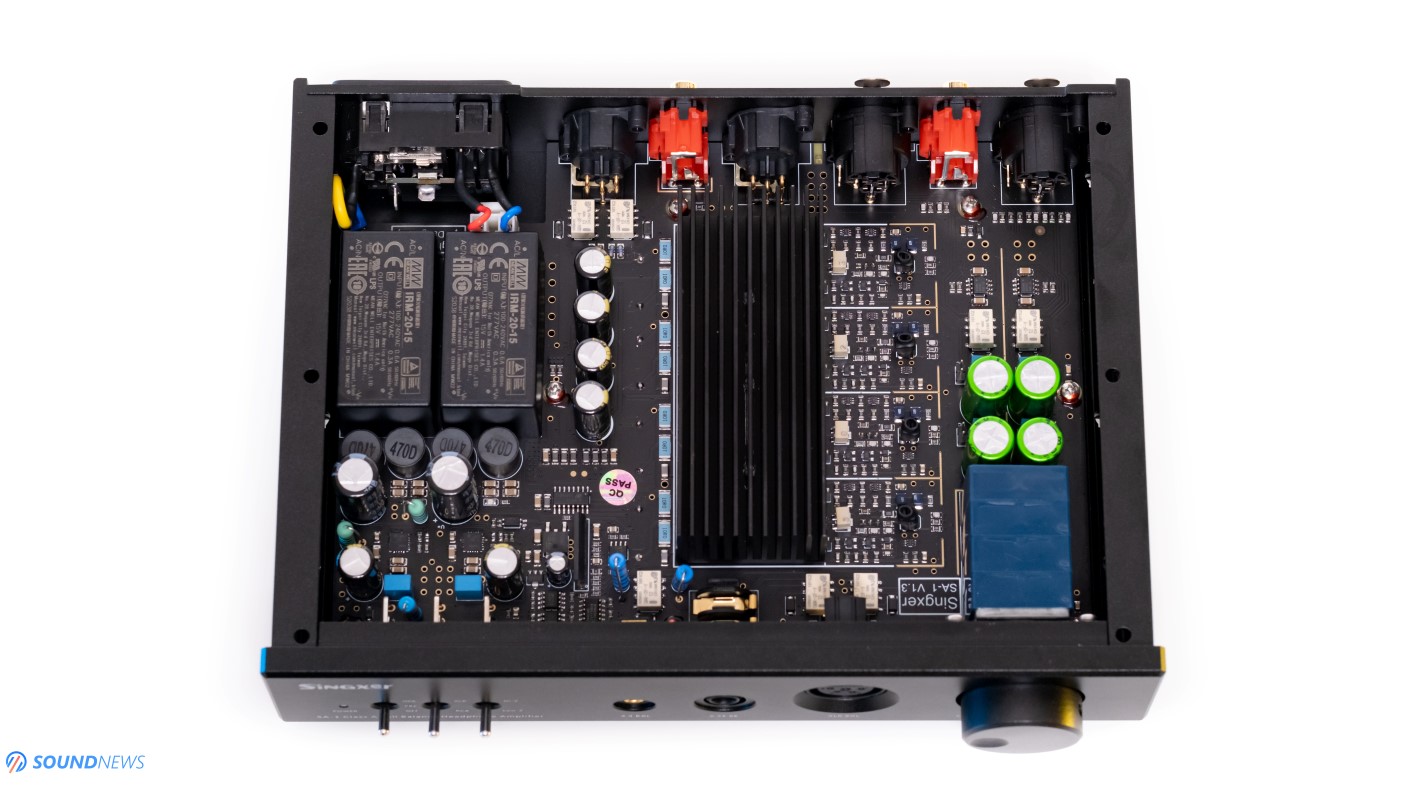
Tech Inside SA-1
As I’ve mentioned before, this is their first headphone amplifier that was designed to be used in a balanced configuration for the best results. According to its specs, it is a fully discrete Class-A amplifier that uses MOSFET transistors at its output stage without a single op-amp in its signal path. It is draining power from two switching-mode power supplies, one for each channel for a lower channel cross-talk. Each power supply outputs 21 Watts, with a total power draining of 42 Watts, but since Class-A amplifiers have an efficiency of around 25%, it is safe to say that it works in Class-A and then it switches to a push-push Class-AB at higher volumes. It isn’t exactly a fully Class-A amplifier, but it is very close to one.
It offers some 6480 mW in 32Ω and 380mW in 600Ω on its balanced outputs and I’m not sure how much power is being offered on its regular jack, since there aren’t any official specifications. Its low gain position uses the unity gain (0 dB) and that is the best gain setting for IEMs and sensitive headphones. Its high-gain adds 11 dB of gain and that could be a slight issue with hard to drive headphones, as usually high-gain sits at around 16 to 30 dB of gain, sometimes even higher, will see about that very soon.
It is a rare sight seeing Nichicon Muse FX capacitors (the green ones), those are some of the best, low ESR, audio-grade capacitors money could buy. I can also spot plenty of regular Nichicon caps around its power supply, used for power filtering and storing and those are always bringing good news.
The most important and probably the most impressive part about this amplifier is its noise output. Honestly, I’ve never seen it so low with desktop amplifiers of any kind, especially with high-power class-A amplifiers that would never happen…until today. Its noise level sits at 0.66 uV (microVolts) that leads to a maximum Signal-to-noise-ratio (SNR) of 147 dB! To put that into perspective the best DACs money could buy have a SNR of around ~132 dB, meaning that with SA-1, the bottle neck would be always your DAC and not the amplifier itself, as it usually happens. As a point of comparison, some of the best measuring headphone amplifiers as Topping A90 have noise floor of 1.4 uV and Benchmark HPA4 has it at 1.9 uV…I almost can’t believe Singxer have done it, but of course I’ll test it with sensitive IEMs very soon and will report back.
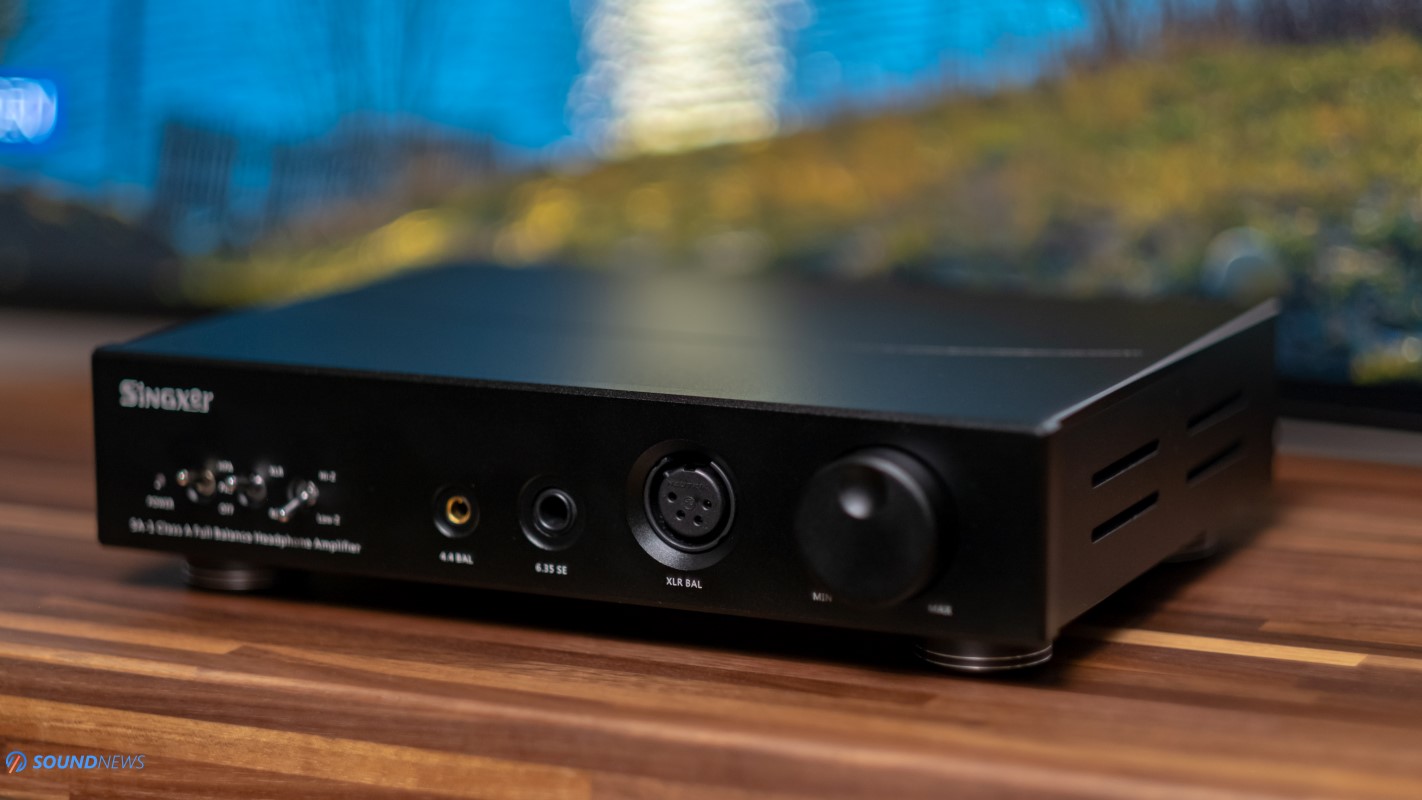
Test Equipment
I wanted to unleash its truest potential, so it was mandatory using it with several high-end D/A converters. I also wanted to check how it performs with a weaker signal via XLR like 3.8V instead of the industry standard 4V and subsequently how it performs with higher voltages like 4.5, 5V and 6V and that is why it was connected to an Audiobyte HydraVox, then to a Matrix Audio Element X and then to a Gustard X26 PRO. I consider them as the best D/A converters that I’ve tried and I am pretty sure that I will be squeezing the best SA-1 has to offer.

Sound Performance
I. Preliminary Sound Impressions
Was there ever a squeaky-clean sounding Class-A amplifier before it, that would completely disappear and leave your music untouched? I don’t think so…even bi-polar amplifiers weren’t that clean and transparent and mind you, those are still considered as the cleanest sounding transistors money could buy. Singxer just completely changed my preconceptions about transistors, but especially about MOSFET Class-A amplifiers. It uses MOSFET transistors and yet, everything is just there in front of me with windows wide open towards my music, removing any veil was left with such kind of amplifiers. At first, I didn’t believe I was listening to a Class-A amplifier, so I’ve cranked that volume higher until there should be some sort of treble itch traditional amplifiers carry with them. My ears started flapping in the air and yet, there wasn’t any brightness, any listening fatigue whatsoever, proving that indeed I’m listening to a transistor-based Class-A amplifier.
It sounds exactly as clean as NFCA and THX-AAA amplifiers, but with an added liquidity that makes the music flow. Tonality wise, it isn’t going towards a super-warm, mid-centric type of sound such amplifiers are usually having. It is more linear and very extended in the frequency response, just without any dryness in the midrange and without bothersome trebles. I’ve fired immediately the 20th Anniversary Edition of Sympathique by Pink Martini (Qobuz / Tidal) that I know very well. There are multiple bells sounding on multiple layers, having difference intensities on Que Sera Sera, some of which could be heard only with uber-transparent amplifiers like Benchmark HPA4 and Topping A90 and there I was sitting, hearing them loud and clear on the SA-1, that beautifully placed all those sounds on their shelves, shinning a bright light towards them all. There were layers and sub-layers of information, with sounds appearing from a higher altitude, from a lower position, even from my far left or right. SA-1 was indeed incredibly detailed and clean sounding, easily on the same level with the most detailed ones, while sounding grand and enveloping, stretching open wide that soundstage, like I was listening to a hybrid tube-based amplifier.
I’ve observed that with the Audiobyte HydraVox that offers a lower voltage of 3.8 V on its XLR output, the high-gain wasn’t enough with some particular headphones. For example, Audeze LCD-4 were almost maxed out, leaving little to no headroom for better mastered music. In my humble opinion, Singxer should go with a higher gain, 16, 20 or 25 dB would be perfect with much harder loads. The good news is that when I’ve switched to a Gustard X26 PRO that outputs a much higher 5V on its XLR, the volume plunged higher and SA-1 was now fully driving the LCD-4 with flying colors, leaving plenty of headroom for higher dynamics. If you find it a little overwhelming at first, I recommend trying a source that can output a higher voltage to the industry standard 4V and you’ll be squeezing more power from it.
All other traits of class-A amplifiers, like a juicy midrange and a more humane treble rendition are still present in this unit, it sounds absolutely beautiful with lean, dry or treble oriented headphones. Hifiman planars sounded absolutely gorgeous with it, taming their upper-end, adding a little bit of soul in that midrange, while fully preserving their clean nature. First impressions are very good, I was not expecting such a clean, undistorted, transparent and natural sounding little amp.

II. Noise Floor
Usually, powerful desktop amplifiers and very sensitive loads don’t belong in the same sentence, as only a handful of units offered a pitch-black background, being completely dead-silent with IEMs. Out of all headphone amps that I’ve tried, I believe that Benchmark HPA4, Sparkos Labs Aries, SMSL SP400 and Topping A90 had the lowest possible noise floor, hence working outstanding with sensitive loads. Achromatic THX-AAA modules don’t guarantee a noiseless performance, as there were several amps that weren’t that clean and distortion free as they want you to believe. Funny thing is that even battery powered devices can struggle with the noise floor, not that many DAPs are truly IEM friendly, even some high-end units weren’t exactly dead-silent with easiest loads.
It still boggles my mind, how on Earth a company that worked only with digital audio, releasing several digital interfaces and DACs, came up with their first ever analog amplifier and at it already beaten every single amp when it comes to noise floor? I seriously need to know more about these people, I really want to shake their hands right now.
I don’t know how Singxer did it, but no matter the selected gain, it could be even high-gain, going almost to the maximum volume with the music on pause, I cannot hear any disturbing noises whatsoever with the most sensitive IEMs I have at my disposal. I’ve tried four of them and it offered a pitch-black background and a noiseless performance. I couldn’t it believe it, so I’ve compared it against a Benchmark HPA4 and sure enough, HPA4 was slightly noisier at close to maximum volume. Of course, nobody can listen at that volume, that power would damage the IEMs and my ear-drums in a split second, still HPA4 was dirtier and SA-1 much cleaner. Only past its 4 O’clock position, very close to its maximum power, there was a faint white noise hidden in the background. I’ve also tried a few Topping amplifiers and those weren’t as clean on high-gain as SA-1 was. At normal listening levels you can easily use the highest sensitivity IEMs even on high gain, you can use sensitive desktop headphones as well and you’ll get the same outstanding results. I was skeptical when I’ve seen its spec sheet, especially those 0.66 uV of noise…but you know that? I am a believer now and I’m crowning the SA-1 as the cleanest and most transparent headphone amplifier I’ve tried up to this point, I’m beyond impressed. Chapeau Bas Singxer!

III. Power Output
Considering its size, its weight and of course its working mode, I believe that almost ~6.5W of power in 32Ω on its balanced outputs is a very respectable number, that with a right source could drive pretty much everything, expect for a few Hifimans as HE-6 or Susvara.
There is one thing that I dislike the most about it: its gain settings, more exactly its high gain that offers an increase of only 11 dB (a 3.8-time magnification). Usually, desktop headphone amplifiers offer a higher gain, somewhere between 16 and 30 dB on their high-gain setting. Here are just several examples: Headamp goes with a gain of ~21 dB on their GSX MKII, Flux Lab Acoustics goes with a gain of 25 dB on their FA-10, Audio-GD goes higher to 31 dB with HE-9, so on and so forth. In simpler words, SA-1 can struggle with several hard to drive headphones as Audeze LCD-4, even Hifiman Arya can pose a small problem. You can solve that issue by adding gain from your source. If your DAC outputs 4V or less on its XLR output, then SA-1 will be almost maxed out with headphones like Audeze LCD-4, but if your DAC provides a higher voltage like 5V (Topping D70S, Gustard X26 PRO) or 6V (Gustard A22), then that will work as a gain increase and SA-1 will offer you back more power, driving harder loads much easier. When I’ve used it with the Audiobyte Hydravox that outputs 3.8V, Singxer struggled a bit and it worked much better with DACs that offered a higher voltage.
I’ve used it the most with a Gustard X26 PRO (5V) and it worked perfectly fine with it, as SA-1 easily drove every headphone I had around, except for the Hifiman Susvara that needs a much higher gain and a lot more power. Everything else sounded mighty impressive, soundstage was stretching wide open, transparency was to die for, detail retrieval challenged the cleanest sounding amplifiers, there was an amazing control of the drivers, bass notes went to the deepest pits, midrange sounded full-bodied and trebles weren’t bothersome at all. I had all the signs of well driven headphone drivers with everything I’ve thrown at it. I’m not going to list all those headphones, but it was immaculate with all of them. If you have a chance of trying a digital or analog source that can offer you a hotter signal, please give that one a try, it should work as a nice gain boost to the SA-1.
As a point of comparison, Audeze LCD-4 were almost maxed out (5 O’clock position) when I was using the HydraVox as the main DAC and I had the same volume between 2 and 3 O’clock position with the X26 PRO…quite a difference.

IV. To Low-Z or to High-Z?
I will tell you right away, that I don’t see the point of increasing the output impedance with 10 Ohms on its High-Z position, but you might have a different opinion or a different sound preference and that is perfectly fine. On High-Z, it smooths out the transient response, offering a softer and a more relaxed presentation, like you’re no longer listening to a solid-state amplifier, but to a hybrid tube-based amplifier. With aggressive sounding headphones that might come in handy, otherwise you’ll be transforming your electronic music into some relaxing synth-pop. No matter the impedance of your headphones, be them 16 or 600 Ohms, you will be limiting the current output on the High-Z and that has a direct impact on the diaphragm control. If you need softer edges and a smoother tube-like experience, then High-Z might be for you, otherwise stick with Low-Z that sounds faster and more engaging. High-Z can also increase the bass output by up to 1 dB with some particular headphones, but that is way too little and I believe that Low-Z and a proper EQ will lead to some better results.
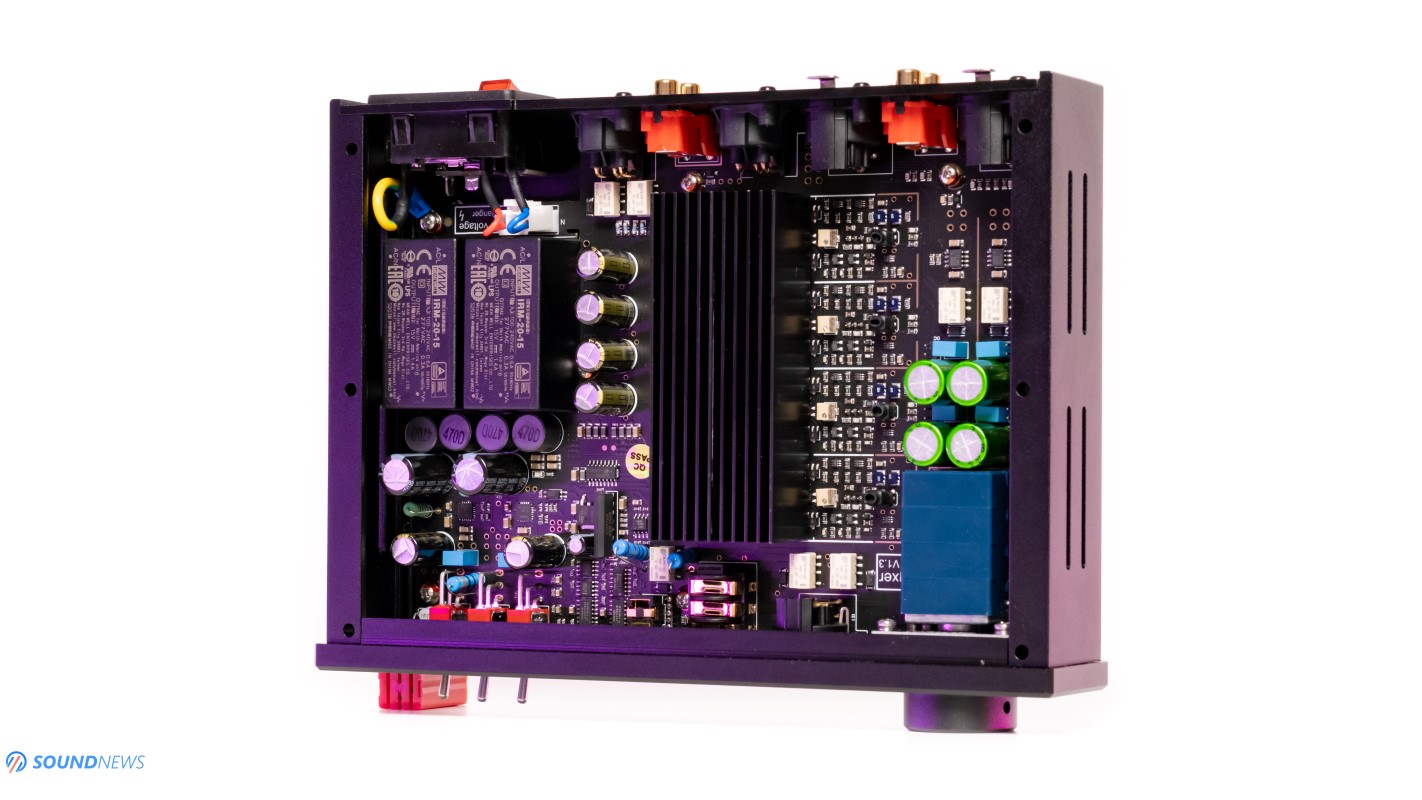
V. Resolution & Transparency
With noise going completely out of the picture, rocking a world-class 147 signal-to-noise-ratio, good luck finding traces of distortion or noise in your tunes, as you will be listening to the limits of your DAC, headphones and of your ears. Living for quite some time with clean sounding amplifiers, I am not that easily impressed and yet SA-1 revealed itself as Mr.Clean, being completely transparent, disappearing from my acoustic chain, while fully preserving all the tiniest details and nuances. I have the highest respect for audio equipment that isn’t adding noise or distortion, with such devices I will be listening only to the truth and to the recording itself and SA-1 can be easily included into that list. A high transparency goes hand in hand with detail retrieval, so it wasn’t a challenge anymore finding micro-details in my tracks, revealing themselves easily without flexing my brain too much. SA-1 is one hell of a clean sounding unit, so you can easily focus on whatever sound you please, in this regard it behaves the same as NFCA and THX-AAA amplifiers. There is one thing I like about SA-1 that surpassed said amplifiers that that is how believable and natural it can sound. There is tiny degree of dryness, a lack of liquidity and natural textures while listening to a Topping or to Benchmark amplifier, but SA-1 doesn’t have any of that. You also won’t find a heavy-weight midrange or a smoothed out treble delivery, SA-1 does that at a much lower scale. There is indeed a little of that Class-A sound that feels powerful, effortless and easy going, but it isn’t overly done. I still find it neutral, but in a good way, carrying plenty of emotions, presenting all the treble information you can wish for, without a hint of brightness. With SA-1, I knew that I’m listening only to the truth and it always offered the last drop of details. I can go on and on about how transparent and detailed SA-1 sounded as there is no other way to describe it.
At the 1 minute and 13 seconds mark on the second track of The Four Seasons by Alan Gilbert and the New York Philharmonic (Qobuz / Tidal) there is a very low intensity sound, like some air is passing through in the background. I couldn’t hear that sound with a lot of amplifiers, headphones and loudspeakers, it wasn’t meant to be heard and yet it was loud and clear with SA-1 driving a pair of Hifiman HE1000SE. On this record, there are many other tiny sounds that aren’t that easy to spot, like feet movements, people touching their musical instruments, people inhaling and exhaling air, but it wasn’t a challenge hearing all that through SA-1, I just passed near all those people, I could see through them and all the tiniest details came forward into the light.
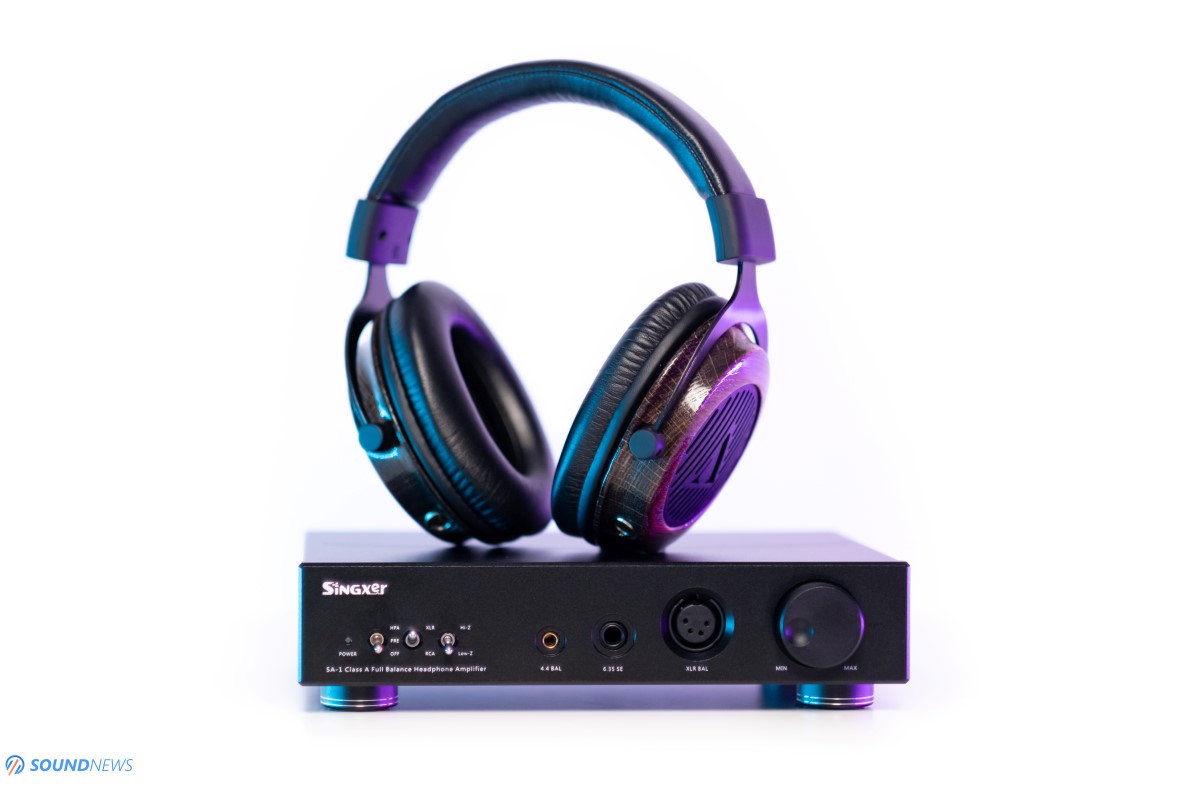
VI. Transient Response
THIS IS THE HARDEST SLAMMING AMPLIFIER THAT WALKS THE FLAT PLANET EARTH!
I’m just messing with you, guys. While, I really like the speed and its uber-fast tempo, easily matching the fastest sounding amplifiers I know of, it will not pound and smash my ear-drums like putting Hulk on a drum kit. This part, the limited gain and power output are the only minuses I see with the Singxer SA-1. Sadly, it isn’t pounding as hard as a Flux Lab Acoustics FA-10 or as a Burson Soloist 3X, hell even Benchmark HPA4 smashes my ear-drums a little harder and that works as dopamine with fast impactful tunes. It is by a hair softer in its presentation, especially the sub-bass doesn’t feel like Mr. Olympia, it isn’t that powerful and hard slamming as I like it to be with several tracks. Put it on High-Z and it becomes even softer and gentler sounding…I would never do that and that is the reason Low-Z seems like the best option if you want to preserve its transient response. With that said, I still find it engaging and fun sounding, just not like the best amplifiers I know of. I’m hearing those double drums crystal clear, but not as loud and imposing as I’m used to, like there is something stopping those headphone drivers from reaching their true potential. Speed is great, it will keep up with the most demanding tracks, but its impact is just good to almost great.
Of course, all this depends a lot on your cans, put some dynamic headphones and it will awake them fully, put some harder to drive headphone like planar-magnetics and you’ll start hearing a difference when it comes to slam. It was too obvious with Audeze LCD-4 and Hifiman HE1000SE and it wasn’t that much with Kennerton Wodan or Erzetich Phobos, so its really depends on your particular pair. I would pair it with a harder slamming digital source, for example it worked best with the Matrix Element X and Gustard X26 PRO as opposed to that musical and smooth sounding Gold Note DS-10 Plus. Mix and match according to your preferences and needs, but in my case ESS-Sabre delta-sigma DACs worked the best with it.
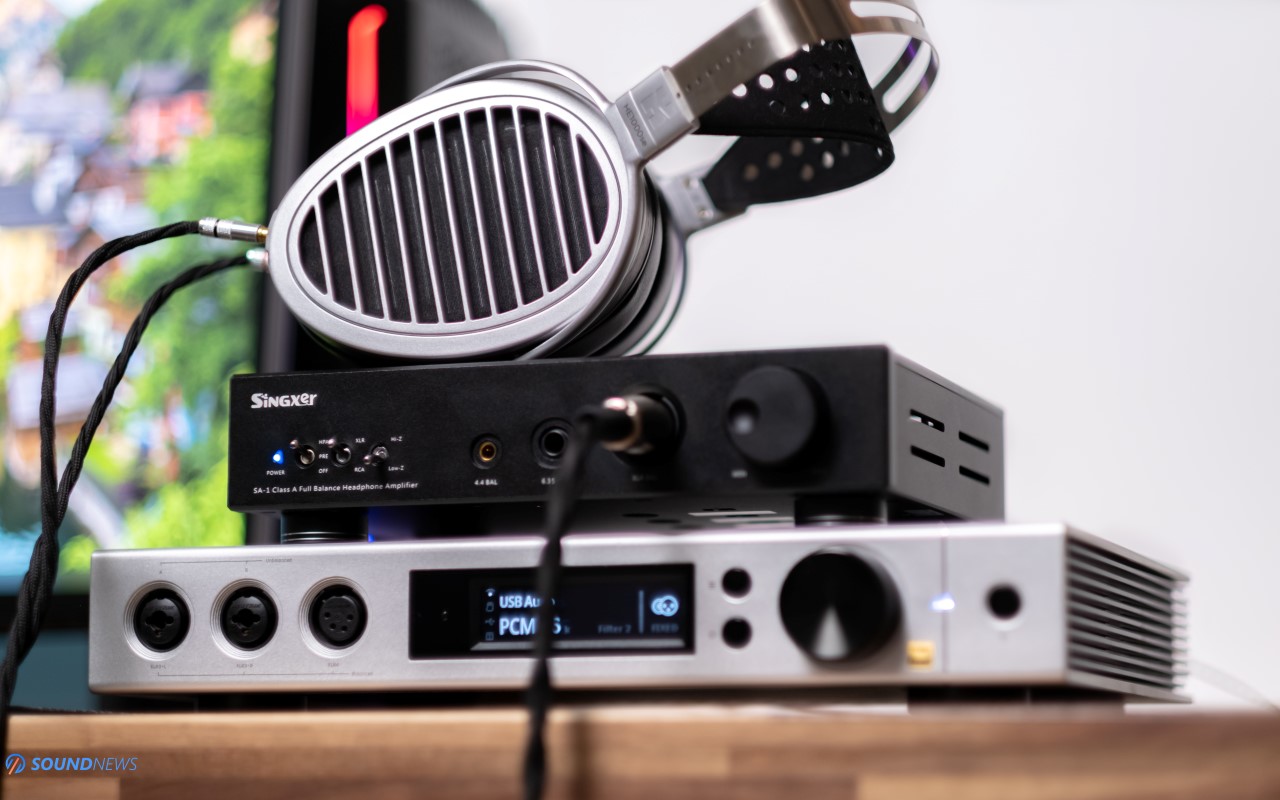
VII. Soundstage & Depth
Boosting transparency and lowering the noise, lets musical notes fly easier around and that can be perceived as a small boost in terms of layering and stage size. Searching for tiny details or focusing on the drummer playing behind the band is not difficult at all and can be perceived as a small boost in terms of depth. Sincerely, I’m yet to hear a closed-in sounding class-A amplifier, as far as solid-state amplifiers go, you can never go wrong with such a working principle when it comes to scale. Transistor-based Class-A amplifiers like this one are delivering the maximum amplitude to your drivers, passing the same current at any load and listening volume, tensioning the magnets of your headphones for an instant power delivery. That is precisely why, units like this one will move air much easier and if your music has plenty of that, you can feel the music expanding, nicely decompressing the song so you could see the full picture in front of you. I would always have at least one Class-A amp sitting on my desk for this reason alone. Singxer SA-1 revealed itself as an airy and wide sounding unit, no matter the song I would listen to.
While it wouldn’t outperform the Flux Lab Acoustics FA-10 or Burson Soloist 3X in terms of scale, it easily outplayed units like Musician Andromeda, SMSL SP400, Benchmark HPA4, Topping A30 PRO and some smaller units. Even crowded progressive rock as The Congregation by Leprous (Qobuz / Tidal) became a lot more atmospheric sounding, leaving a profound impression that I am listening to a complex amplifier. From an anxious sound that struggled with smaller amplifiers, I felt more air crawling between headphone drivers and my own ears, tempering the overall presentation. With all that said, it will not artificially boost the soundstage size, it will render all that information as close as possible to the original intent of the mastering engineer. If I would be listening to a live album, then it will start sounding bigger, wider and vice-versa it would decrease the amount of air in the room with a cozier record.

VIII. Frequency Response
SA-1 is an amplifier that doesn’t like to stay in front of the musical signal, it’s a wire with gain unit, going for an extra-clean presentation, while being very extended in the frequency response. I find it ruler flat, ranging from the lowest pits of sub-bass to the highest treble peaks.
A. Bass
Sub-bass is incredibly detailed and clean sounding, delivering ample power on the spot, easily reaching 20 Hz notes with demanding tracks and sustaining longer bass notes if that would be necessary. It has layers and sub-layers of it, it presented a nimble type of bass, opposed to a hard slamming one. I presume a higher capacitance would be needed for a better bass slam, moving to push-pull Class-AB at higher volumes could also be the culprit in here. Switching mode power supplies and Class-A amps don’t go that well together, maybe that is also a limiting factor. All things considered, don’t worry that much, it is still impressive in here, just not on the same level with the best I’ve tried. Mid-bass is pretty much the same, without drops or rises, it was tactile and fun with headphones as Audeze LCD-4 and Kennerton Wodan.
B. Midrange
That beautiful Class-A midrange is still present, offering a slight warmth and a higher degree of emotion compared to traditional amplifiers. MOSFET amplifiers like this one, always had a natural tonality, improving the listening experience in the long run and this can be said about the SA-1 as well. It isn’t syrupy or overly dense sounding as it happens with others, I believe that it offers a perfect balance between being technical and natural sounding. I liked that jazz and rock music presented natural overtones, highlighting musical instruments and boosting the vocal performance. While midrange is always linear, never standing out too much, there is something about it that makes you listen to more and more music without any listening fatigue. Even a higher volume for a brief moment didn’t bother me that much. This is an outstanding midrange performance and if you are getting a Class-A amp, you’re buying it for its tonality and SA-1 fully delivered on that.
C. Treble
When it comes to treble, you’ll be hearing everything in here, even past top-octave if you’re young enough. It is a wide bandwidth amp, so you’ll be hearing tambourines, cymbals and bells in a crystal-clear manner. The lack of distortion at higher registers, works as a smoothing filter, you can hear the treble energy, but all that isn’t bothering even for a moment. No ringing = no distortion = no brightness. Treble oriented headphones worked exceptionally well with it, Hifiman HE1000SE is the best example I can give. SA-1 tamed that hotter treble, while preserving its detailed and clean performance. It wasn’t rolling off treble at all, it would just make it less invasive and more pleasing, so you can listen to bright headphones all day long.
Overall, SA-1 presented a super-extended frequency response, playing it extra safe in the treble, but less impressive when it comes to landing punches in the bass.

Conclusion
Considering I’m testing the first analog amplifier of a company that worked only with digital audio, I’m deeply impressed by the final result, as I’ve never experienced such a clean and detailed sounding Class-A amplifier before, that was completely silent on high-gain and close to its maximum volume with ultra-sensitive IEMs and that is not an easy task to do. There are two things that bothered me in the long run: its 11 dB of gain is too little for several planar-magnetic headphones, creating an impression that it isn’t that powerful which obviously isn’t the case, hence recommending higher voltage sources that works as a gain boost. Secondly, its slight softness when delivering bass notes wasn’t pleasant with my electronic music collection, I wanted more raw energy from it like what I’m hearing from a Burson Soloist 3X, if they can solve those issues with their next amplifier, they will surely have a winner on their hands.
Nonetheless, there is a lot to like about this one, its price per Watt is exceptional, you’re getting natural overtones and liquidity of class-A amplifiers, but also a lot of cleanness and a higher degree of transparency at just $599. It stood its ground compared to pricier amplifiers, it sounded grand, open wide and really deep on its balanced outputs, it exposed my music completely without adding brightness and too much sharpness. It worked exceptionally well with brighter headphones, smoothing-out the leading edges and boosting its tonal density. It paired outstanding with Hifiman, Erzetich headphones and it should work as good with Sennheiser, Beyerdynamic and Grado cans too. It just won a Silver Award for its technicalities, for its tonality and for its affordable price tag. Congratulation to the team and I hope they’ll use my constructive feedback, crafting better devices in the future.

Singxer SA-1 was kindly provided by fine gents of Apos Audio, it can be purchased from their web-store by following this link (Apos is offering free shipping in the USA and Canada, free 45-day returns in case you don’t like it, an extra year of warranty and they will price match the lowest one you can find online).
If you get one, please come back and leave a comment, I’m very curious to know how it performs in your headphone or loudspeaker setup! 😉
PROS:
- Old-school look
- Outstanding build quality
- Noise-less with ultra-sensitive IEMs (even on high-gain)
- Clean, undistorted and super-transparent with everything I’ve thrown at it
- Impressive levels of resolution for a Class-A amp
- Offers an extended frequency response
- Could drive plenty of headphones if you use the right source
- Sounds open wide, very layered, fully preserving the depth information
- Precise pin-point imaging
- Natural overtones make it a spectacular amp to be used with dry or bright sounding headphones
- Outstanding pace, rhythm and timing, speedy sounding all the time
- A very good value
CONS:
- Its high gain of 11 dB isn’t enough with low-sensitivity headphones
- Difficult access to its gain switches
- A nicer punch would be nice to have
- It needs a remote control to be used as a preamplifier in a loudspeaker setup
ASSOCIATED EQUIPMENT:
- DACs: Audiobyte HydraVox & HydraZap, Matrix Audio Element X, Gold Note DS-10 Plus & PSU-10 EVO, Gustard X26 PRO, Gustard X16, Topping D30 PRO
- DAPs: Shanling M8, M3X, FiiO M15
- Headphone Amps: Singxer SA-1, Benchmark HPA4, SparkoS Labs Aries, Flux Lab Acoustics FA-10, Burson Soloist 3X, Musician Andromeda, SMSL SP400, Topping A90, Topping A30 PRO, Gustard H16
- Power Amps: KECES S300, SMSL DA-9
- IEMs: FiiO FA9, FH7, FH5S, FD5, Meze Rai Penta, Rai Solo, LittleDot Cu KIS, Hiby Crystal 6 & others
- Portable headphones: Sennheiser Momentum 2, Meze 99 Classics
- Full-sized headphones: Hifiman Susvara, Hifiman HE1000SE, HE400SE, Audeze LCD-4, Erzetich Phobos, Erzetich Mania, Kennerton Wodan, Magni, Gjallarhorn, Vali, M12S, Quad ERA-1, Ollo S4X Reference & others
- Loudspeakers: KEF Reference 3, Natural Sound NS-17
- Interconnects: QED Reference (x2), Topping TCX1 (x2)
- Speaker cables: Kimber PR8, Audioquest Type4
- Power Cables: Isotek EVO3 Premier (x3)
- Balanced Isolation Power Conditioners: PLiXiR Elite BAC400



